A cellular micro-RNA, let-7i, regulates Toll-like receptor 4 expression and contributes to cholangiocyte immune responses against Cryptosporidium parvum infection
- PMID: 17660297
- PMCID: PMC2194650
- DOI: 10.1074/jbc.M702633200
A cellular micro-RNA, let-7i, regulates Toll-like receptor 4 expression and contributes to cholangiocyte immune responses against Cryptosporidium parvum infection
Abstract
Toll-like receptors (TLRs) are important pathogen recognition molecules and are key to epithelial immune responses to microbial infection. However, the molecular mechanisms that regulate TLR expression in epithelia are obscure. Micro-RNAs play important roles in a wide range of biological events through post-transcriptional suppression of target mRNAs. Here we report that human biliary epithelial cells (cholangiocytes) express let-7 family members, micro-RNAs with complementarity to TLR4 mRNA. We found that let-7 regulates TLR4 expression via post-transcriptional suppression in cultured human cholangiocytes. Infection of cultured human cholangiocytes with Cryptosporidium parvum, a parasite that causes intestinal and biliary disease, results in decreased expression of primary let-7i and mature let-7 in a MyD88/NF-kappaB-dependent manner. The decreased let-7 expression is associated with C. parvum-induced up-regulation of TLR4 in infected cells. Moreover, experimentally induced suppression or forced expression of let-7i causes reciprocal alterations in C. parvum-induced TLR4 protein expression, and consequently, infection dynamics of C. parvum in vitro. These results indicate that let-7i regulates TLR4 expression in cholangiocytes and contributes to epithelial immune responses against C. parvum infection. Furthermore, the data raise the possibility that micro-RNA-mediated post-transcriptional pathways may be critical to host-cell regulatory responses to microbial infection in general.
Figures
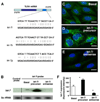
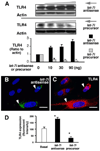
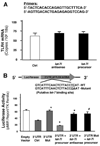
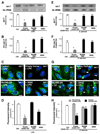

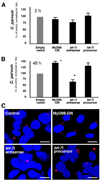
Similar articles
-
Multiple TLRs are expressed in human cholangiocytes and mediate host epithelial defense responses to Cryptosporidium parvum via activation of NF-kappaB.J Immunol. 2005 Dec 1;175(11):7447-56. doi: 10.4049/jimmunol.175.11.7447. J Immunol. 2005. PMID: 16301652
-
Cryptosporidium parvum induces SIRT1 expression in host epithelial cells through downregulating let-7i.Hum Immunol. 2014 Aug;75(8):760-5. doi: 10.1016/j.humimm.2014.05.007. Epub 2014 May 24. Hum Immunol. 2014. PMID: 24862934 Free PMC article.
-
miR-27b targets KSRP to coordinate TLR4-mediated epithelial defense against Cryptosporidium parvum infection.PLoS Pathog. 2012;8(5):e1002702. doi: 10.1371/journal.ppat.1002702. Epub 2012 May 17. PLoS Pathog. 2012. PMID: 22615562 Free PMC article.
-
Innate immune responses against Cryptosporidium parvum infection.Parasite Immunol. 2013 Feb;35(2):55-64. doi: 10.1111/pim.12020. Parasite Immunol. 2013. PMID: 23173616 Review.
-
Regulation of host epithelial responses to Cryptosporidium infection by microRNAs.Parasite Immunol. 2017 Feb;39(2). doi: 10.1111/pim.12408. Parasite Immunol. 2017. PMID: 27977858 Review.
Cited by
-
Decreased expression of microRNA let-7i and its association with chemotherapeutic response in human gastric cancer.World J Surg Oncol. 2012 Oct 29;10:225. doi: 10.1186/1477-7819-10-225. World J Surg Oncol. 2012. PMID: 23107361 Free PMC article.
-
MicroRNA-16 inhibits the lipopolysaccharide-induced inflammatory response in nucleus pulposus cells of the intervertebral disc by targeting TAB3.Arch Med Sci. 2018 Apr 6;17(2):500-513. doi: 10.5114/aoms.2018.74950. eCollection 2021. Arch Med Sci. 2018. PMID: 33747285 Free PMC article.
-
MicroRNAs of parasites: current status and future perspectives.Parasitol Res. 2010 Aug;107(3):501-7. doi: 10.1007/s00436-010-1927-6. Epub 2010 Jun 8. Parasitol Res. 2010. PMID: 20532562 Review.
-
Identification of differentially expressed miRNAs in chicken lung and trachea with avian influenza virus infection by a deep sequencing approach.BMC Genomics. 2009 Nov 5;10:512. doi: 10.1186/1471-2164-10-512. BMC Genomics. 2009. PMID: 19891781 Free PMC article.
-
Let-7 microRNA as a potential therapeutic target with implications for immunotherapy.Expert Opin Ther Targets. 2018 Nov;22(11):929-939. doi: 10.1080/14728222.2018.1535594. Epub 2018 Oct 17. Expert Opin Ther Targets. 2018. PMID: 30328720 Free PMC article. Review.
References
-
- Takeda K, Kaisho T, Akira S. Annu. Rev. Immunol. 2003;21:335–376. - PubMed
-
- Akira S, Takeda K. Nat. Rev. Immunol. 2004;4:499–511. - PubMed
-
- Modlin RL, Cheng G. Nat. Med. 2004;10:1173–1174. - PubMed
-
- Strober W. Nat. Med. 2004;10:898–900. - PubMed
-
- Campos MA, Campos MA, Closel M, Valente EP, Cardoso JE, Akira S, Alvarez-Leite JI, Ropert C, Gazzinelli RT. J. Immunol. 2004;172:1711–1718. - PubMed
Publication types
MeSH terms
Substances
Grants and funding
LinkOut - more resources
Full Text Sources
Other Literature Sources
Medical
Molecular Biology Databases

